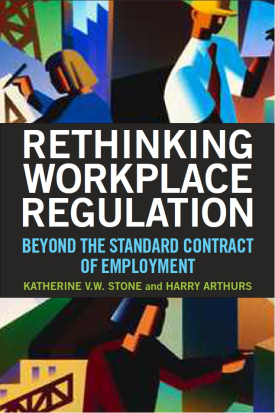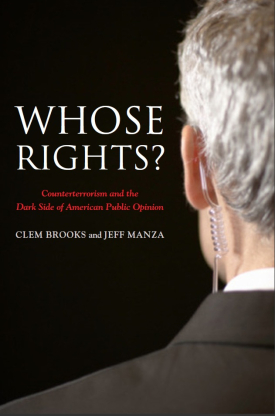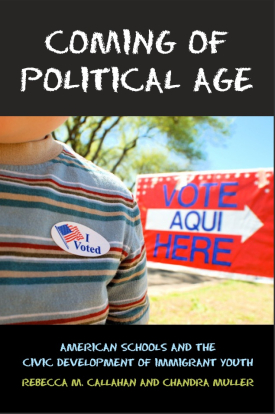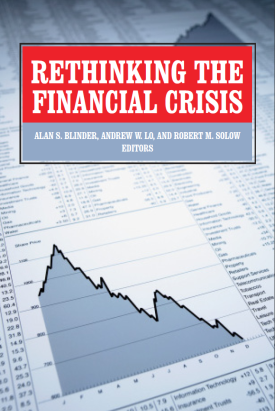An estimated nine million US residents live in “mixed-status” households that include at least one unauthorized adult and one or more US-born children. These children are in a unique political position: they enjoy the rights of US citizenship but they are also confronted with the legal exclusion of their parents. How does political socialization work when the parents themselves do not enjoy basic civil and political rights and are subject to deportation? Do the children of the undocumented take advantage of their rights as citizens?
The U.S. Latino population has grown substantially in recent years, with Latinos now comprising the largest ethnic group in the country. Given the increasing politicization of this growing segment of the U.S. population, researchers and policy analysts are devoting a considerable amount of attention to questions concerning public opinion, participation, and representation within the Latino community.

Rethinking Workplace Regulation
About This Book
During the middle third of the twentieth century, workers in most industrialized countries secured a substantial measure of job security, whether through legislation, contract or social practice. This “standard employment contract,” as it was known, became the foundation of an impressive array of rights and entitlements, including social insurance and pensions, protection against unsociable working conditions, and the right to bargain collectively. Recent changes in technology and the global economy, however, have dramatically eroded this traditional form of employment. Employers now value flexibility over stability, and increasingly hire employees for short-term or temporary work. Many countries have also repealed labor laws, relaxed employee protections, and reduced state-provided benefits. As the old system of worker protection declines, how can labor regulation be improved to protect workers? In Rethinking Workplace Regulation, nineteen leading scholars from ten countries and half a dozen disciplines present a sweeping tour of the latest policy experiments across the world that attempt to balance worker security and the new flexible employment paradigm.
Edited by noted socio-legal scholars Katherine V.W. Stone and Harry Arthurs, Rethinking Workplace Regulation presents case studies on new forms of dispute resolution, job training programs, social insurance and collective representation that could serve as policy models in the contemporary industrialized world. The volume leads with an intriguing set of essays on legal attempts to update the employment contract. For example, Bruno Caruso reports on efforts in the European Union to “constitutionalize” employment and other contracts to better preserve protective principles for workers and to extend their legal impact. The volume then turns to the field of labor relations, where promising regulatory strategies have emerged. Sociologist Jelle Visser offers a fresh assessment of the Dutch version of the ‘flexicurity’ model, which attempts to balance the rise in nonstandard employment with improved social protection by indexing the minimum wage and strengthening rights of access to health insurance, pensions, and training. Sociologist Ida Regalia provides an engaging account of experimental local and regional “pacts” in Italy and France that allow several employers to share temporary workers, thereby providing workers job security within the group rather than with an individual firm. The volume also illustrates the power of governments to influence labor market institutions. Legal scholars John Howe and Michael Rawling discuss Australia's innovative legislation on supply chains that holds companies at the top of the supply chain responsible for employment law violations of their subcontractors. Contributors also analyze ways in which more general social policy is being renegotiated in light of the changing nature of work. Kendra Strauss, a geographer, offers a wide-ranging comparative analysis of pension systems and calls for a new model that offers “flexible pensions for flexible workers.”
With its ambitious scope and broad inquiry, Rethinking Workplace Regulation illustrates the diverse innovations countries have developed to confront the policy challenges created by the changing nature of work. The experiments evaluated in this volume will provide inspiration and instruction for policymakers and advocates seeking to improve worker’s lives in this latest era of global capitalism.
KATHERINE V.W. STONE is Arjay and Frances Fearing Miller Professor of Law at University of California, Los Angeles.
HARRY ARTHURS is former Dean of Osgoode Hall Law School and University Professor Emeritus and President Emeritus of York University.
CONTRIBUTORS: Takashi Araki, Thomas Bredgaard, Cesar G. Canton, Bruno Caruso, Consuelo Chacartegui, Alexander J.S. Colvin, Mark Freedland, Morley Gunderson, Thomas Haipeter, John Howe, Robert Kuttner, Julia Lopez, Keisuke Nakamura, Michio Nitta, Anthony O'Donnell, Michael Rawling, Ida Regalia, Kendra Strauss, Julie C. Suk, Jelle Visser.
RSF Journal
View Book Series
Sign Up For Our Mailing List
Apply For Funding

Whose Rights?
About This Book
In the wake of the September 11 attacks, the U.S. government adopted a series of counterterrorism policies that radically altered the prevailing balance between civil liberties and security. These changes allowed for warrantless domestic surveillance, military commissions at Guantanamo Bay and even extralegal assassinations. Now, more than a decade after 9/11, these sharply contested measures appear poised to become lasting features of American government. What do Americans think about these policies? Where do they draw the line on what the government is allowed to do in the name of fighting terrorism? Drawing from a wealth of survey and experimental data, Whose Rights? explores the underlying sources of public attitudes toward the war on terror in a more detailed and comprehensive manner than has ever been attempted.
In an analysis that deftly deploys the tools of political science and psychology, Whose Rights? addresses a vexing puzzle: Why does the counterterrorism agenda persist even as 9/11 recedes in time and the threat from Al Qaeda wanes? Authors Clem Brooks and Jeff Manza provocatively argue that American opinion, despite traditionally showing strong support for civil liberties, exhibits a “dark side” that tolerates illiberal policies in the face of a threat. Surveillance of American citizens, heightened airport security, the Patriot Act and targeted assassinations enjoy broad support among Americans, and these preferences have remained largely stable over the past decade. There are, however, important variations: Waterboarding and torture receive notably low levels of support, and counterterrorism activities sanctioned by formal legislation, as opposed to covert operations, tend to draw more favor. To better evaluate these trends, Whose Rights? examines the concept of “threat-priming” and finds that getting people to think about the specter of terrorism bolsters anew their willingness to support coercive measures. A series of experimental surveys also yields fascinating insight into the impact of national identity cues. When respondents are primed to think that American citizens would be targeted by harsh counterterrorism policies, support declines significantly. On the other hand, groups such as Muslims, foreigners, and people of Middle Eastern background elicit particularly negative attitudes and increase support for counterterrorism measures. Under the right conditions, Brooks and Manza show, American support for counterterrorism activities can be propelled upward by simple reminders of past terrorism plots and communication about disliked external groups.
Whose Rights? convincingly argues that mass opinion plays a central role in the politics of contemporary counterterrorism policy. With their clarity and compelling evidence, Brooks and Manza offer much-needed insight into the policy responses to the defining conflict of our age and the psychological impact of terrorism.
CLEM BROOKS is professor of sociology at Indiana University, Bloomington.
JEFF MANZA is professor of sociology at New York University.
RSF Journal
View Book Series
Sign Up For Our Mailing List
Apply For Funding

Coming of Political Age
About This Book
As one of the fastest-growing segments of the American population, the children of immigrants are poised to reshape the country’s political future. The massive rallies for immigration rights in 2006 and the recent push for the DREAM Act, both heavily supported by immigrant youth, signal the growing political potential of this crucial group. While many studies have explored the political participation of immigrant adults, we know comparatively little about what influences civic participation among the children of immigrants. Coming of Political Age persuasively argues that schools play a central role in integrating immigrant youth into the political system. The volume shows that the choices we make now in our educational system will have major consequences for the country’s civic health as the children of immigrants grow and mature as citizens.
Coming of Political Age draws from an impressive range of data, including two large surveys of adolescents in high schools and interviews with teachers and students, to provide an insightful analysis of trends in youth participation in politics. Although the children of both immigrant and native-born parents register and vote at similar rates, the factors associated with this likelihood are very different. While parental educational levels largely explain voting behavior among children of native-born parents, this volume demonstrates that immigrant children’s own education, in particular their exposure to social studies, strongly predicts their future political participation. Learning more about civic society and putting effort into these classes may encourage an interest in politics, suggesting that the high school civics curriculum remains highly relevant in an increasingly disconnected society. Interestingly, although their schooling predicts whether children of immigrants will vote, how they identify politically depends more on family and community influences. As budget cuts force school administrators to realign academic priorities, this volume argues that any cutback to social science programs may effectively curtail the political and civic engagement of the next generation of voters.
While much of the literature on immigrant assimilation focuses on family and community, Coming of Political Age argues that schools—and social science courses in particular—may be central to preparing the leaders of tomorrow. The insights and conclusions presented in this volume are essential to understand how we can encourage more participation in civic action and improve the functioning of our political system.
REBECCA M. CALLAHAN is assistant professor of education at the University of Texas at Austin.
CHANDRA MULLER is professor of sociology at the University of Texas at Austin.
RSF Journal
View Book Series
Sign Up For Our Mailing List
Apply For Funding

Rethinking the Financial Crisis
About This Book
Some economic events are so major and unsettling that they “change everything.” Such is the case with the financial crisis that started in the summer of 2007 and is still a drag on the world economy. Yet enough time has now elapsed for economists to consider questions that run deeper than the usual focus on the immediate causes and consequences of the crisis. How have these stunning events changed our thinking about the role of the financial system in the economy, about the costs and benefits of financial innovation, about the efficiency of financial markets, and about the role the government should play in regulating finance? In Rethinking the Financial Crisis, some of the nation’s most renowned economists share their assessments of particular aspects of the crisis and reconsider the way we think about the financial system and its role in the economy.
In its wide-ranging inquiry into the financial crash, Rethinking the Financial Crisis marshals an impressive collection of rigorous and yet empirically-relevant research that, in some respects, upsets the conventional wisdom about the crisis and also opens up new areas for exploration. Two separate chapters–by Burton G. Malkiel and by Hersh Shefrin and Meir Statman – debate whether the facts of the financial crisis upend the efficient market hypothesis and require a more behavioral account of financial market performance. To build a better bridge between the study of finance and the “real” economy of production and employment, Simon Gilchrist and Egan Zakrasjek take an innovative measure of financial stress and embed it in a model of the U.S. economy to assess how disruptions in financial markets affect economic activity—and how the Federal Reserve might do monetary policy better. The volume also examines the crucial role of financial innovation in the evolution of the pre-crash financial system. Thomas Philippon documents the huge increase in the size of the financial services industry relative to real GDP, and also the increasing cost per financial transaction. He suggests that the finance industry of 1900 was just as able to produce loans, bonds, and stocks as its modern counterpart—and it did so more cheaply. Robert Jarrow looks in detail at some of the major types of exotic securities developed by financial engineers, such as collateralized debt obligations and credit-default swaps, reaching judgments on which make the real economy more efficient and which do not. The volume’s final section turns explicitly to regulatory matters. Robert Litan discusses the political economy of financial regulation before and after the crisis. He reviews the provisions of the Dodd-Frank Wall Street Reform and Consumer Protection Act of 2010, which he considers an imperfect but useful response to a major breakdown in market and regulatory discipline.
At a time when the financial sector continues to be a source of considerable controversy, Rethinking the Financial Crisis addresses important questions about the complex workings of American finance and shows how the study of economics needs to change to deepen our understanding of the indispensable but risky role that the financial system plays in modern economies.
ALAN S. BLINDER is the Gordon S. Rentschler Memorial Professor of Economics and Public Affairs at Princeton University.
ANDREW W. LO is Charles E. and Susan T. Harris Professor at M.I.T.
ROBERT M. SOLOW is Institute Professor, Emeritus, at M.I.T.
CONTRIBUTORS: Ben S. Bernanke, Patrick Bolton, J. Bradford DeLong, Christopher L. Foote, Kristopher S. Gerardi, Simon G. Gilchrist, John Hull, Robert A. Jarrow, Robert E. Litan, Burton G. Malkiel, Kevin J. Murphy, Thomas Philippon, Tano Santon, Jose A. Scheinkman, Hersh Shefrin, Meir Statman, Alan White, Paul S. Willen, Egon Zakrajsek.
RSF Journal
View Book Series
Sign Up For Our Mailing List
Apply For Funding
Recent research has identified important shifts in the physical location of poor urban Americans. The concentration of poverty in the United States roughly doubled between 1970 and 1990, and then declined in the 1990s before reverting to an upward trend in recent years. What is striking and yet to be fully grasped is how the urban geography of poverty has changed over the past decade and how this impacts poor Americans. In 2000, the typical urban pattern was one of contiguous tracts with high poverty.
- April 2018: Supplemental funding of $21,800 granted.
The notable increase in immigration in the U.S. over the past half century, coupled with its recent geographic dispersion into new communities nationwide, has fueled contact between immigrants and the native-born across a wider front than ever before. However, the consequences of contact within this context of ethnic diversity, particularly for key social outcomes such as trust and civic engagement, are far from clear.
In a democratic system, elected officials are expected to represent their constituents’ interests and preferences when shaping public policy. But in a diverse society such as the U.S., where people often have divergent or conflicting views, a question arises about whose preferences actually prevail when lawmakers shape policy.
- July 2016: Additional funding of $70,000 awarded to support the additional programming time and effort required to convert the PDF files that can be read by text analysis software.
Data from several national surveys suggests that while economic inequality has been on the rise, public support for redistributive policy has remained constant or declined. This is puzzling because the long-standing median voter theory suggests that the general response to increasing inequality will be a greater demand for redistribution.
Pagination
- Previous page
- Page 26
- Next page
